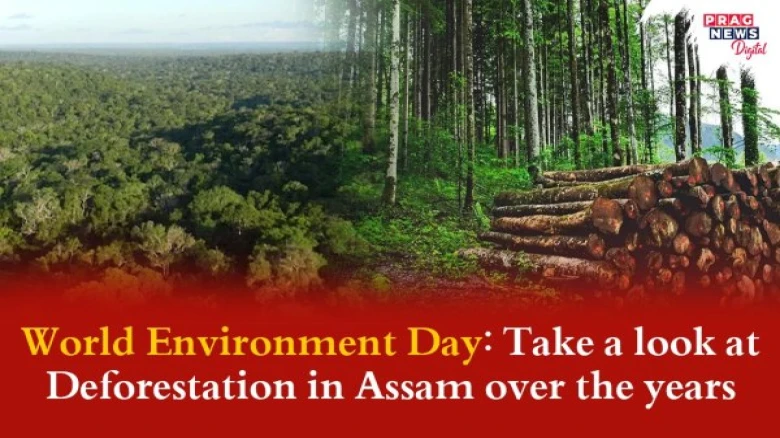Regional

The importance of the environment is highlighted on World Environment Day, which serves as a reminder to people not to harm the nature; let's check the details of harm caused to forestation in Assam.
Digital Desk: In the previous decade and a half, deforestation has been a major environmental worry for the state of Assam, resulting in one of many issues, such as pollution and health concerns.
According to the India State of Forest Report released in 2009, Assam's documented forest area was 26,832 square kilometers, accounting for 34.21 percent of the state's total geographical area.

Reserved Forests account for 66.58 percent of the total forest area, while Unclassified Forests account for 33.42 percent.
As per reports, the forests of Assam are positioned in one of India's two big biodiversity hotspots, the Eastern Himalayas and the Western Ghats.
Compared to India, Assam has a forest proportion of roughly 3.88 percent. Assam is a diverse landscape with mountains, mild hills, great rivers, and expansive plains with lush vegetation.
In Assam's largely agricultural environment, the forest regions form a network of habitat patches. As a result, the state's diverse flora and fauna are well-known. However, only 5000 of India's 15,000 flowering species are found in this area.
Things you should know:
In Assam, 45,91,980 households use firewood for cooking.
According to the Census of India, 2011, Out of 45,91,980 households, 4,10,071 households use crop residue, 54,137 households use cow dung cake as fuel, 6,834 households use coal, lignite, or charcoal, 39,792 households use kerosene, 7,546 households use biogas and 12,06,621 households who use LPG.

However, deforestation is caused by a wide variety of factors such as agriculture, pasture expansion, flood and erosion, forest product consumption, export, population pressure, encroachment, inter-state border aggression, illegal timbering, poaching, and wildlife trafficking, and all these had resulted in losing a significant amount of green cover in recent years in Assam.
According to a recent study conducted by the Indian Institute of Remote Sensing, forests in areas of Assam and Arunachal Pradesh will be depleted by 2028 by 9,007.14 sq km (2.94%). Dhemaji district (1,419.99 sq km) had the most forest cover loss, followed by Sonitpur district (825.85 sq km), Lohit district in Arunachal (820.61 sq km) in Assam, Tinsukia district (662.28 sq km), and Lakhimpur district (662.28 sq km) (635.15 sq km).
Read here about the Forest Man of India:
Jadav "Molai" Payeng (born 1963), often known as the Forest Man of India, is an environmental activist and forestry worker from Majuli.
He has planted and managed trees on a sandbar of the river Brahmaputra for decades, transforming it into a forest reserve.

The Molai forest, named after him, is located near Kokilamukh in Jorhat, Assam, India, and covers approximately 1,360 acres / 550 hectares.
In 2015, he was awarded the Padma Shri, India's fourth highest civilian honour. He was born into Assam's indigenous Mising tribe.
Today is World Environment Day it's the environment in which we live might be thought of as a protective blanket that protects life on the planet. It is essential for the health of all living organisms. It satisfies all human requirements by providing food, shelter, and air. It also ensures that the earth's ecological equilibrium is maintained.

The day is observed worldwide to honor and acknowledge all that the environment has given us and resolve to safeguard it. On this day, governments and ordinary citizens join forces to raise awareness about certain environmental issues.
Leave A Comment